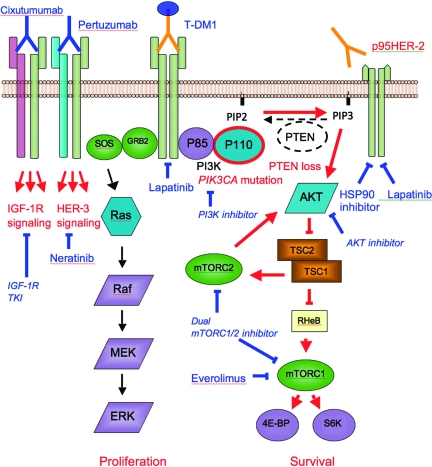Figure 2.
Illustration of main mechanisms of trastuzumab resistance (in red) and targeted agents to circumvent resistance (in blue). Truncated HER-2 expression prevents binding of trastuzumab. Alternative signaling, such as through HER-3, can lead to continued downstream signaling. The PI3K–AKT pathway can be constitutively activated through loss of PTEN or PIK3CA mutations. Lapatinib inhibits downstream signaling of HER-2 and p95HER-2. T-DM1 provides additional cytotoxic activity. HSP90 inhibitors, such as tanespimycin, lead to degradation of p95HER-2. Pertuzumab prevents dimerization of HER-2 and HER-3. Cixutumumab inhibits IGF-1R. Everolimus is a mTORC1 inhibitor. Other investigational agents in early clinical development are also shown in italics.
Abbreviations: ERK, extracellular signal–related kinase; GRB2, growth factor receptor-bound protein 2; HER-2, human epidermal growth factor receptor; HSP90, heat shock protein 90; IGF-1R, insulin-like growth factor 1 receptor; MEK, mitogen-activated protein kinase/ERK kinase; mTORC1, mammalian target of rapamycin complex 1; mTORC2, mammalian target of rapamycin complex 2; PI3K, phosphoinositide 3-kinase; PIP2, phosphatidylinositol-bisphosphate; PIP3, phosphatidylinositol-trisphosphate; PTEN, phosphatase and tensin homologue deleted on chromosome ten; RHeB, Ras homolog enriched in brain; SOS; son of sevenless; T-DM1, trastuzumab–DM1 conjugate; TKI, tyrosine kinase inhibitor; TSC, tuberous sclerosis protein.

